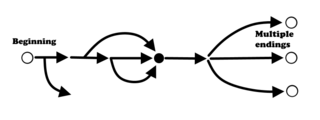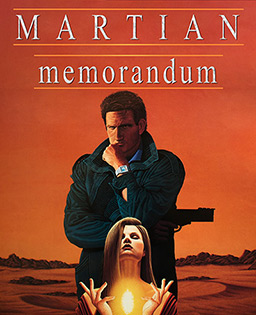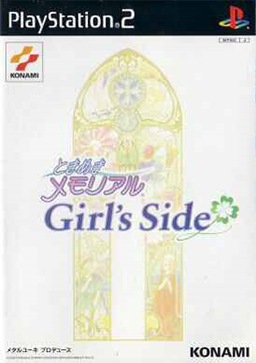Dating sims, or romance simulation games, are a video game subgenre of simulation games with romantic elements. While dating sims share a similar visual presentation as visual novels, they are distinct genres. Dating sims are largely dependent on statistics, while visual novels focus on telling a branching story. Nevertheless, the term "dating sim" has become a generic term for romance-driven games in the West.
Interactive storytelling is a form of digital entertainment in which the storyline is not predetermined. The author creates the setting, characters, and situation which the narrative must address, but the user experiences a unique story based on their interactions with the story world. The architecture of an interactive storytelling program includes a drama manager, user model, and agent model to control, respectively, aspects of narrative production, player uniqueness, and character knowledge and behavior. Together, these systems generate characters that act "human," alter the world in real-time reactions to the player, and ensure that new narrative events unfold comprehensibly.
A visual novel (VN) is a form of digital interactive fiction. Visual novels are often associated with the medium of video games, but are not always labeled as such themselves. They combine a textual narrative with static or animated illustrations and a varying degree of interactivity. The format is more rarely referred to as novel game, a retranscription of the wasei-eigo term noberu gēmu (ノベルゲーム), which is more often used in Japanese.

Tokimeki Memorial is a dating simulation series by Konami. It consists of eight main games in addition to many spin-offs. The games are notable in the dating sim genre for being highly nonlinear. Their nickname amongst their fans is the contraction TokiMemo.
A bishōjo game or gal game is "a type of Japanese video game centered on interactions with attractive girls".
The following outline is provided as an overview of and topical guide to video games:
An interactive film is a video game or other interactive media that has characteristics of a cinematic film. In the video game industry, the term refers to a movie game, a video game that presents its gameplay in a cinematic, scripted manner, often through the use of full-motion video of either animated or live-action footage.

A video game with nonlinear gameplay presents players with challenges that can be completed in a number of different sequences. Each player may take on only some of the challenges possible, and the same challenges may be played in a different order. Conversely, a video game with linear gameplay will confront a player with a fixed sequence of challenges: every player faces every challenge and has to overcome them in the same order.
A narrative typically ends in one set way, but certain kinds of narrative allow for multiple endings.

Martian Memorandum is a dystopian cyberpunk/noir graphic adventure game that was originally released in 1991 for MS-DOS. It was developed and published by Access Software. The game is the second in the series of Tex Murphy mysteries; its immediate sequel is Under a Killing Moon. The game is set in 2039, several years after Mean Streets.
An otomegame is a story-based romance video game targeted towards women with a female protagonist as the player character. Generally one of the goals, besides the main story goal, is to develop a romantic relationship between the female main player character and one of the usually male, secondary lead characters.

The Portopia Serial Murder Case is a 1983 adventure game designed by Yuji Horii and published by Enix. It was first released on the NEC PC-6001 and has since been ported to other personal computers, the Family Computer (Famicom), mobile phone services and most recently, Windows as Square Enix showing off their natural language processing technology.

Tokimeki Memorial Girl's Side is a dating sim video game targeted towards women and girls released by Konami for the PlayStation 2 game console on June 20, 2002. It was also re-released with enhancements for the Nintendo DS as Tokimeki Memorial Girl's Side: 1st Love on February 15, 2007. A remaster of the Nintendo DS version for the Nintendo Switch was released on February 14, 2024. It has three sequels: Tokimeki Memorial Girl's Side: 2nd Kiss, Tokimeki Memorial Girl's Side: 3rd Story, and Tokimeki Memorial Girl's Side: 4th Heart. Tokimeki Memorial Girl's Side is part of the Tokimeki Memorial series, which originated in 1994 as a male-oriented dating sim.

Nakayama Miho no Tokimeki High School is a 1987 dating sim developed by Square and Nintendo R&D1, and published by Nintendo exclusively in Japan for the Famicom Disk System. The game was released on December 1, 1987. It was one of the first dating sim games. It was designed by Hironobu Sakaguchi, who also created the Final Fantasy series, and Yoshio Sakamoto, who co-created Metroid. The music for the game was composed by Nobuo Uematsu and Toshiaki Imai. Pop idol Miho Nakayama contributed her name and likeness and voice-acted tie-in segments that could be accessed by calling toll-free phone numbers revealed during the progress of gameplay.
An adventure game is a video game genre in which the player assumes the role of a protagonist in an interactive story, driven by exploration and/or puzzle-solving. The genre's focus on story allows it to draw heavily from other narrative-based media, such as literature and film, encompassing a wide variety of genres. Most adventure games are designed for a single player, since the emphasis on story and character makes multiplayer design difficult. Colossal Cave Adventure is identified by Rick Adams as the first such adventure game, first released in 1976, while other notable adventure game series include Zork, King's Quest, Monkey Island, Syberia, and Myst.

A non-player character (NPC), also called a non-playable character, is a character in a game that is not controlled by a player. The term originated in traditional tabletop role-playing games where it applies to characters controlled by the gamemaster or referee rather than by another player. In video games, this usually means a character controlled by the computer that has a predetermined set of behaviors that potentially will impact gameplay, but will not necessarily be the product of true artificial intelligence.

Sakura Wars 2: Thou Shalt Not Die is a cross-genre video game developed by Red Company and Sega, and published by Sega for the Sega Saturn. The second installment in the main Sakura Wars series, it was released in April 1998 and later ported to other systems, including to the Dreamcast in September 2000. Defined as a "dramatic adventure" game, Sakura Wars 2 combines overlapping tactical role-playing, dating sim and visual novel gameplay elements.

Sakura Wars 3: Is Paris Burning? is a cross-genre video game developed by Red Company and Overworks and published by Sega for the Dreamcast. The third installment in the Sakura Wars series, it was released in March 2001. Defined by its publisher as a "dramatic adventure" game, Is Paris Burning? combines overlapping tactical role-playing, dating sim and visual novel gameplay elements.

Sakura Wars 4: Fall in Love, Maidens is a cross-genre video game developed by Red Entertainment and Overworks and published by Sega for the Dreamcast. The fourth main installment in the Sakura Wars series and the last for Sega home consoles, it was released in March 2002. Defined by its publisher as a "dramatic adventure" game, Sakura Wars 4 combines overlapping tactical role-playing, dating sim and visual novel gameplay elements.











